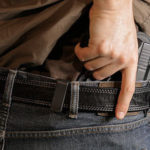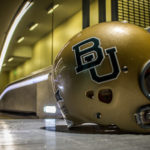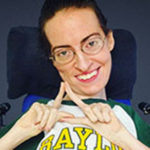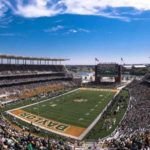WACO—Baylor University marked the 71st anniversary of the atomic bombing of Nagasaki, Japan, by launching a yearlong display of the Nagasaki Cross, a sculpture made of materials salvaged from a middle school building damaged by the blast.
The cross is exhibited in the foyer of Moody Memorial Library and will move to other campus locations throughout the academic year.
 Japanese artist Inagaki Yoshinori created the Nagasaki Cross. (Courtesy Photo)Japanese artist Inagaki Yoshinori created the cross as a remembrance of “man-made miseries,” including the nuclear bombings of Hiroshima and Nagasaki, as well as the devastating earthquake and tsunami in March 2011 that triggered widespread devastation and led to a nuclear accident at the Fukushima Daiichi Nuclear Power Plant.
Japanese artist Inagaki Yoshinori created the Nagasaki Cross. (Courtesy Photo)Japanese artist Inagaki Yoshinori created the cross as a remembrance of “man-made miseries,” including the nuclear bombings of Hiroshima and Nagasaki, as well as the devastating earthquake and tsunami in March 2011 that triggered widespread devastation and led to a nuclear accident at the Fukushima Daiichi Nuclear Power Plant.
The Nagasaki Cross also serves as an uplifting reminder of rebirth and revitalization made possible through Christ’s death on the cross and his resurrection, Baylor officials noted.
Mutual devotion to Christ
Member universities of the International Association of Baptist Colleges and Universities that have exchange programs with Seinan Gakuin University in Japan, as Baylor has had since 1971, are sharing the cross as a symbol of amity from one Baptist institution to another in recognition of religious kinship and mutual devotion to Jesus Christ.
 The Nagasaki Cross was created from materials salvaged from the demolition site of a middle school damaged by the atomic blast. (Courtesy Photo)“The cross sculpted from debris left after the detonation of a plutonium bomb over Nagasaki on Aug. 9, 1945, is a symbol of the divine power that triumphs over all earthly powers,” Baylor Interim President David Garland said.
The Nagasaki Cross was created from materials salvaged from the demolition site of a middle school damaged by the atomic blast. (Courtesy Photo)“The cross sculpted from debris left after the detonation of a plutonium bomb over Nagasaki on Aug. 9, 1945, is a symbol of the divine power that triumphs over all earthly powers,” Baylor Interim President David Garland said.
“Crafted by a Japanese Christian and displayed at Baptist colleges and universities across America, this cross is also a testimony that Christ indeed is our peace and that in his flesh he has broken down the dividing wall of the hostility between us and made us one,” Garland continued, quoting Ephesians 2:15.
 Cast into the face of the cross are the letters “Nagasaki” on the cross-right horizontal, “Hiroshima” on the cross-left horizontal and “Fukushima” on the vertical above the cross-piece, and the numbers 19458689 (1945 Aug. 6, when Hiroshima was bombed, and Aug. 9, when Nagasaki was bombed) and 2011311 (2011 March 11, when the earthquake and tsunami occurred) descending the vertical below the cross piece. (Courtesy photo)The cross measures just over 14.5 inches tall and about 6.75 inches wide and weighs more than 6.5 pounds. Cast into the cross face are the letters “Nagasaki” on the cross-right horizontal, “Hiroshima” on the cross-left horizontal and “Fukushima” on the vertical above the cross-piece, and the numbers 19458689 (1945 Aug. 6, when Hiroshima was bombed, and Aug. 9, when Nagasaki was bombed) and 2011311 (2011 March 11, when the earthquake and tsunami occurred) descending the vertical below the cross piece.
Cast into the face of the cross are the letters “Nagasaki” on the cross-right horizontal, “Hiroshima” on the cross-left horizontal and “Fukushima” on the vertical above the cross-piece, and the numbers 19458689 (1945 Aug. 6, when Hiroshima was bombed, and Aug. 9, when Nagasaki was bombed) and 2011311 (2011 March 11, when the earthquake and tsunami occurred) descending the vertical below the cross piece. (Courtesy photo)The cross measures just over 14.5 inches tall and about 6.75 inches wide and weighs more than 6.5 pounds. Cast into the cross face are the letters “Nagasaki” on the cross-right horizontal, “Hiroshima” on the cross-left horizontal and “Fukushima” on the vertical above the cross-piece, and the numbers 19458689 (1945 Aug. 6, when Hiroshima was bombed, and Aug. 9, when Nagasaki was bombed) and 2011311 (2011 March 11, when the earthquake and tsunami occurred) descending the vertical below the cross piece.
Sign up for our weekly edition and get all our headlines in your inbox on Thursdays
The atomic bomb, known as “Fat Man,” exploded about 1,500 feet above ground and 1,500 feet northeast of Chinsei Academy Middle School in Nagasaki. The explosion collapsed the school’s fourth floor, turned the third floor’s north wall to rubble and completely burned the interior.
In 1949, the Kassui Academy assumed responsibility for the Chinsei site and repaired the building for continued use. In 2011, as the building was being demolished, officials invited Yoshinori to create a peace memorial on the site.
Beauty from a demolition site
As Yoshinori thought about the memorial, one of the largest recorded earthquakes in Japan’s history on March 11, 2011, generated a 23-foot tsunami that, while wreaking other devastation, set off a nuclear accident at the power plant. Just as Americans use “9/11” as shorthand for the Sept. 11, 2001, terrorist attacks on the United States, so in Japan the 2011 Tohoku earthquake and tsunami have become “the 3/11 disasters.”
“While working on other projects, I had occasionally been touched by the thought of those local inhabitants,” Yoshinori noted. “But it was at the height of the March 11 disasters, the earthquakes and the nuclear reactor explosions, that I decided it was time for me as an artist to create the peace memorial; to leave for the next generation a tool for succession and hope. And so I took from the demolition site some scraps of reinforcing rod so they would not disappear in burial but be recreated anew in the form of the Nagasaki Cross.”
Emphasizing that the cross’ materials “have been reborn into a new existence by passing them once again through a cast iron furnace,” Yoshinori added, “Undoubtedly, this reminds us of nothing less than the cross, which stood as an instrument of execution on the hill of Golgotha, and our complete purification and cleansing from the curse through Christ’s suffering.”
‘Redeeming power of God’s love and grace’
Kathy Hillman, associate professor and director of Baptist collections and library advancement at the Baylor Libraries, and a graduate student created the display around the Nagasaki Cross.
“The Nagasaki Cross serves as a stark symbol of tragedy and loss while reminding us of the redeeming power of God’s love and grace that transcends the past,” Hillman said.
Jeffrey Hamilton, vice provost in Baylor’s Center for Global Engagement, told the Waco Tribune-Herald that although the bombing occurred more than seven decades ago, the cross holds modern significance for today’s students.
“Students are very familiar with the Holocaust and sometimes less familiar with bombings that were part of World War II,” Hamilton said in the Tribune-Herald. “To see a physical remnant of destruction transformed into a symbol of peace and God’s truth is inspiring.”
Yoshinori was born in Japan’s Saga Prefecture in 1928. He earned degrees from Tokyo University specializing in philosophy, law and Christian history, as well as a doctorate in literature from American Catholic University. He taught at Nazan University, Fukuoka Women’s Academy and Kyushu University, where he is professor emeritus, and currently teaches at Nagasaki Junshin University.














We seek to connect God’s story and God’s people around the world. To learn more about God’s story, click here.
Send comments and feedback to Eric Black, our editor. For comments to be published, please specify “letter to the editor.” Maximum length for publication is 300 words.